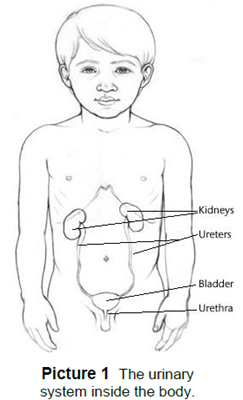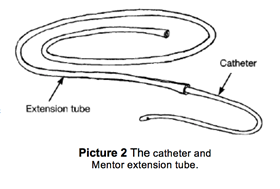Catheterization - Self-Clean Intermittent - Male
![]()

Clean intermittent catheterization (kath-e-ter-i-ZA-shun) is done by passing a tube through the urethra into the bladder. Catheterization empties urine from the bladder (Picture 1). When the bladder is not emptied completely, bacteria (germs) can grow and cause a urinary tract infection
(UTI) that can hurt the kidneys. Because the kidneys are the main way for liquid waste products to get out of the body, they must be protected from infections. Proper emptying of the bladder and good medical treatment will help do this.
Catheterization schedule
-
Catheterization must be done at regularly scheduled times to empty the bladder properly.
-
Do the first catheterization when you get up in the morning.Do the last catheterization at your bedtime, unless your doctor tells you otherwise.
-
It is important to follow the catheterization instructions carefully to help prevent urinary tract infections.
You will need
- Catheter
- Plastic bag or toothbrush holder to carry the catheter
- Toilet tissue
- Soap and washcloth or a Wet Wipe®
- Water-soluble lubricating jelly (Do not use petroleum jelly products such as Vaseline®)
Getting ready
- Wash your hands with soap and water or a Wet Wipe®, then rinse and dry.
- Position yourself in one of these ways:
- Sit on the toilet.
- Sit in your wheelchair facing the toilet.
- Stand in front of the toilet if you can.
- Wash the tip of your penis with soap and water or a Wet Wipe®.
- Squeeze a small amount of lubricating jelly onto the toilet tissue.Roll the small end of the catheter (tip) in the jelly and about 2 inches down from the tip.You can also squeeze the lubricating jelly onto the tip of the catheter.
How to insert the catheter
- Hold the penis up and away from your body. Do not hold too tightly or you will squeeze the urethra shut.

- Insert the catheter gently but firmly into the urethra (opening).As the catheter goes in, it will meet resistance from a tight muscle.Continue inserting the catheter but do not use force (Picture 2).Take a slow, deep breath to help loosen the tight muscle.
- Keep inserting the catheter until urine begins to flow.Then insert it about 2 more inches.
- Let the urine flow into the toilet.
- When the urine stops flowing, gently insert the catheter about another 1/2 inch to check for any more urine.Change your position a little and strain, grunt or cough a few times to help get all the urine out.
- Slowly remove the catheter.Let any urine in the catheter drip into the toilet.Hold up both ends of the catheter in your hand to keep urine from spilling on your clothes.
- If you are using a Coude tip catheter, insert it with the "hooked end" pointing up.
Care of the catheter
-
Wash your hands with soap and water.
- Wash the catheter, inside and out, with soap and water by rubbing it between your hands.
- Rinse the catheter well and dry it with a clean towel or tissue.
- Put the catheter in a plastic bag, pencil case, toothbrush holder or other carrying case.Use a new plastic bag every day.If you use another type of case, wash it out once a day with soap and water and let it air-dry.
- Wash and dry your hands.
You may rinse the catheters, inside and out, with full-strength distilled white vinegar as needed to prevent crystals from forming inside the catheter.
Other information
- Always use the lubricating jelly when catheterizing yourself to help prevent injury to the urethra.
- If you are going to be in a place where soap and water are not available, you can carry Wet Wipes® for washing your hands and penis.
- If you do not have soap and water or a Wet Wipe®, catheterize anyway.It is more important for urine be emptied from your bladder regularly to help prevent infection and kidney damage.
- If you drop your only catheter on the ground, and there is no soap, water or a Wet Wipe®, wipe it off as best you can then go ahead and catheterize.It is more important to catheterize to empty urine from your bladder.Be sure to drain all the urine from your bladder.Remember to strain, grunt, change your position or cough to help empty the bladder.
- The catheter may be kept in a plastic bag, toothbrush holder or pencil case and carried in your book bag or pocket.
- Catheters may be reused until they are too limp to handle or until they begin to crack.(Usually, about once a month, you will need to get new catheters.)
- Do not flush catheters down the toilet.
- If you need more support to steady yourself while sitting on the toilet, bars can be attached to the wall or cabinet beside your toilet for you to hold onto.Ask your nurse about this.
- Catheter extension tubing, made by Mentor, will let you catheterize while sitting in your wheelchair.The urine goes through a long tube and drains into the toilet.
When to call the doctor
Call your doctor or the Myelomeningocele Clinic at (614) 722-5725 if any of the following occurs:
- Blood in the urine
- Chills, or fever over 100°F by mouth or axillary (under the arm)
- Nausea or vomiting
- Pain or tenderness across the lower back
- Dark, cloudy urine
- Change in the smell of the urine. (Does it have a bad odor or have a strong smell?)
- Trouble inserting the catheter
Please call the Urology Nurses at 614-722-6630 or send a MyChart message to the Urology Clinic or the Myelomeningocele Clinic at 614-722-5275.
HH-II-49 8/79, Reviewed 8/17 Copyright 1979, Nationwide Children’s Hospital
